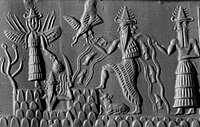Ningal
| Part of a series on |
| Ancient Mesopotamian religion |
|---|
 |
Primordial beings
|
Seven gods who decree
|
Other major deities
|
Minor deities
|
Demigods and heroes
|
Spirits and monsters
|
Tales
|
Related topics |
|
Ningal (𒀭𒊩𒌆𒃲 DNIN.GAL, "Great Lady/Queen") was a goddess of reeds in the Sumerian mythology, daughter of Enki and Ningikurga and the consort of the moon god Nanna by whom she bore the sun god Utu, his sister Inanna, and in some texts, Ishkur. She is chiefly recognised at Ur, and was probably first worshipped by cow-herders in the marsh lands of southern Mesopotamia.
| An | |||||||||||||||||||||||||||||||||||||||||||||||||||||||||||||||||||
| Ninḫursaĝ | Enki born to Namma |
Ninkikurga born to Namma |
Nidaba born to Uraš |
Ḫaya | |||||||||||||||||||||||||||||||||||||||||||||||||||||||||||||||
| Ninsar | Ninlil | Enlil | |||||||||||||||||||||||||||||||||||||||||||||||||||||||||||||||||
| Ninkurra | Ningal maybe daughter of Enlil |
Nanna | Nergal maybe son of Enki |
Ninurta maybe born to Ninḫursaĝ |
Baba born to Uraš |
||||||||||||||||||||||||||||||||||||||||||||||||||||||||||||||
| Uttu | Inanna possibly also the daughter of Enki, of Enlil, or of An |
Dumuzid maybe son of Enki |
Utu | Ninkigal married Nergal |
|||||||||||||||||||||||||||||||||||||||||||||||||||||||||||||||
| Meškiaĝĝašer | Lugalbanda | Ninsumun | |||||||||||||||||||||||||||||||||||||||||||||||||||||||||||||||||
| Enmerkar | Gilgāmeš | ||||||||||||||||||||||||||||||||||||||||||||||||||||||||||||||||||
| Urnungal | |||||||||||||||||||||||||||||||||||||||||||||||||||||||||||||||||||
References
Jordan, Michael (2002). Encyclopedia of Gods. Kyle Cathie..mw-parser-output cite.citation{font-style:inherit}.mw-parser-output q{quotes:"""""""'""'"}.mw-parser-output code.cs1-code{color:inherit;background:inherit;border:inherit;padding:inherit}.mw-parser-output .cs1-lock-free a{background:url("//upload.wikimedia.org/wikipedia/commons/thumb/6/65/Lock-green.svg/9px-Lock-green.svg.png")no-repeat;background-position:right .1em center}.mw-parser-output .cs1-lock-limited a,.mw-parser-output .cs1-lock-registration a{background:url("//upload.wikimedia.org/wikipedia/commons/thumb/d/d6/Lock-gray-alt-2.svg/9px-Lock-gray-alt-2.svg.png")no-repeat;background-position:right .1em center}.mw-parser-output .cs1-lock-subscription a{background:url("//upload.wikimedia.org/wikipedia/commons/thumb/a/aa/Lock-red-alt-2.svg/9px-Lock-red-alt-2.svg.png")no-repeat;background-position:right .1em center}.mw-parser-output .cs1-subscription,.mw-parser-output .cs1-registration{color:#555}.mw-parser-output .cs1-subscription span,.mw-parser-output .cs1-registration span{border-bottom:1px dotted;cursor:help}.mw-parser-output .cs1-hidden-error{display:none;font-size:100%}.mw-parser-output .cs1-visible-error{font-size:100%}.mw-parser-output .cs1-subscription,.mw-parser-output .cs1-registration,.mw-parser-output .cs1-format{font-size:95%}.mw-parser-output .cs1-kern-left,.mw-parser-output .cs1-kern-wl-left{padding-left:0.2em}.mw-parser-output .cs1-kern-right,.mw-parser-output .cs1-kern-wl-right{padding-right:0.2em}
This article relating to a myth or legend from the ancient Middle East is a stub. You can help Wikipedia by expanding it. |


Comments
Post a Comment